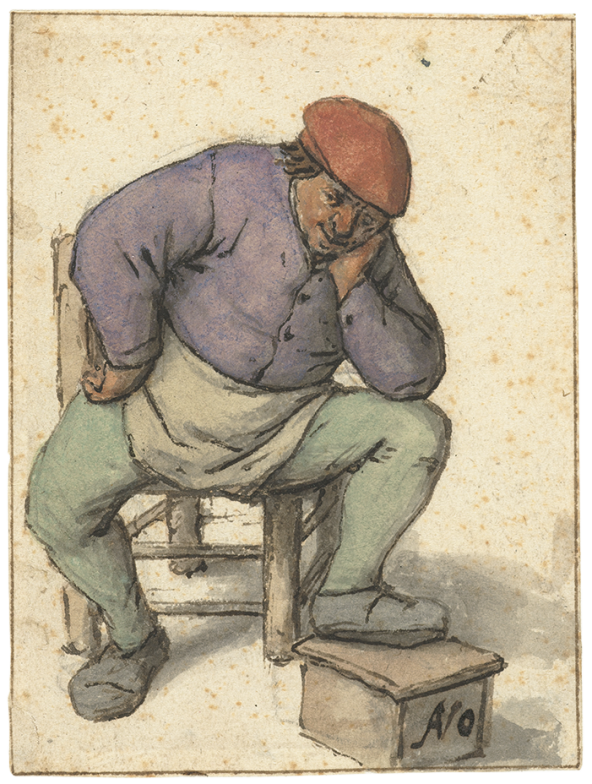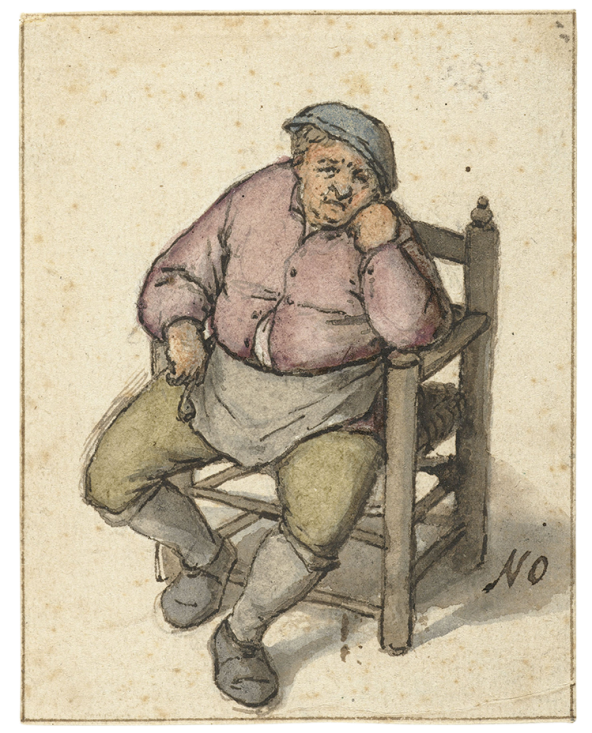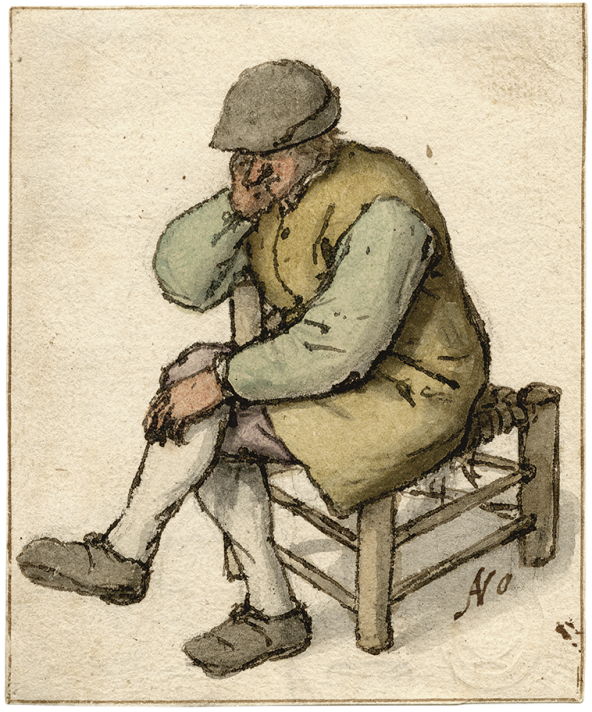Choose a background colour
Adriaen van Ostade, Dutch, 1610-1685: Study of a Seated Man Holding a Pipe, c. 1670-80
Pen in brown ink and brush with watercolors on paper; framing lines in light brown ink.
3 7⁄16 × 2 7⁄8 in. (8.7 × 7.3 cm)
Recto, lower right, pen and brown ink, monogrammed by the artist, AVO; verso, lower center, in pen, N. Massaloff; upper left, in pencil, COLL.: P.v.Amstel / Blokhuizen / Straeter / Massaloff; upper center, Boern. 29.4.31 / 23410 / X; center, 831; lower left, [indiscernible]; and lower right, Ad.S. / Ploos v. Am. / Blockhuyz.
- Chain Lines:
- Horizontal, 24 mm.
- Watermark:
- None.
- Provenance:
Possibly Johan van der Marck, 1707 – 1772, Leiden (Lugt 3001); possibly his sale, De Winter & IJver, Amsterdam, 29 November 1773 (and following days), Album E, lot 346; Cornelis Ploos van Amstel, 1726 – 1798, Amsterdam (Lugt 2034); Dirk Vis Blokhuyzen, 1799 – 1869, Rotterdam; August Sträter, 1810 – 1897, Aachen (Lugt 787, mark on verso); his sale, H. G. Gutekunst, Stuttgart, May 1898, lot 1163; Nicolas Mosolov, 1847 – 1914, Moscow (Lugt 1802, signature on verso); gift to the Museum Roumiantzoff, 1914 (Lugt 1524); Museum of Fine Arts, Moscow, consolidated from the Museum Roumiantzoff; sale, C. G. Boerner, Leipzig, April, 1931, lot 171; private collection, Switzerland; sale, Galerie Kornfeld, Bern, 15 June 1988, lot 131; Sheldon and Leena Peck, Boston (Lugt 3847); gift to the Ackland Art Museum, inv. no. 2017.1.58.
- Literature/Exhibitions:
Massaloff [or Mosolov] 1917, 318; Schnackenburg 1981, vol. 1, 144, no. 321, vol. 2, 146, no. 321; Sadkov 2010, Appendix II, 382, no. B21.
- Ackland Catalogue:
- 2017.1.58
A man holding a pipe and conveying a sense of listlessness or boredom, sits cross-legged in a chair cobbled-together chair from pieces of recycled wood. Adriaen van Ostade created a number of similar small-scale drawings in watercolor showing men smoking, dancing, and playing games. Such figures were often featured in his celebrated tavern scene paintings. This study does not appear in any known finished composition, but rather belongs to a group of three other sheets, each showing a seated man resting his head on his hand. Together, they may have represented a set offered to a collector.
Adriaen van Ostade made a number of these charming, small-scale figure studies in watercolor. Three other sheets relate specifically to this one (two in the Rijksmuseum, and one in the Special Collections of the Leiden University Libraries), each showing a seated man resting his head on his hand Fig. 62.1 Fig. 62.2 Fig. 62.3.1

Adriaen van Ostade, Study of a Seated Man. Pen in brown ink and brush in watercolor on paper, 91 × 61 mm. Amsterdam, Rijksmuseum, inv. no. RP-T-1881-A-113.
Rijksmuseum, Amsterdam

Adriaen van Ostade, Study of a Seated Man Holding a Pipe. Pen in brown ink and brush in watercolor on paper, 92 × 71 mm. Amsterdam, Rijksmuseum, inv. no. RP-T1881-A-112.
Rijksmuseum, Amsterdam

Adriaen van Ostade, Study of a Seated Man with Legs Crossed. Pen in brown ink and brush in watercolor on paper, 82 × 72 mm. Universitaire Bibliotheken Leiden, inv. no. PK-T-AW-31.
Universitaire Bibliotheken Leiden
All four are signed by the artist with his AVO monogram. Van Ostade produced dozens of other small-scale drawn figure studies showing men smoking, dancing, playing games, or engaging in any number of activities that one also finds in his paintings and prints.2
Although some of his small studies still pose questions of attribution, and others were retouched by his pupil, Cornelis Dusart (1660 – 1704), all four of these drawings appear to be solely the work of Van Ostade alone.3
Because of their degree of finish and the signatures, he likely intended these for the collector’s market, even given their diminutive size. Possibly, he once offered them as a set.
According to Bernhard Schnackenburg, most of Van Ostade’s drawings with watercolor date to the latter part of his career.4
This accords with the story told by Arnold Houbraken (1660 – 1719) that Van Ostade fled invading French troops in 1672, first with the intent of moving to Lübeck in Germany, but never making it out of Amsterdam. There he took up in earnest the medium of watercolor (being away from his paints and studio) in the house of a supportive art lover and wealthy silk dyer named Constantijn Sennepart (1625 – 1703).5
A significant number of highly finished multi-figure watercolor drawings signed and dated by the artist indeed date to the latter part of his career. It seems reasonable to presume that these four related studies date to this period as well. They display all of the sophistication of technique that Van Ostade developed in his larger watercolors, using saturated colors, for example, to develop a convincing sense of directional light, as seen in the Peck drawing around the man’s chest and along his sleeves.
Van Ostade’s depictions of men with their heads propped on one hand can occasionally be found among the cast of characters featured in his tavern scenes, though none in this particular group of four studies were used in any known work by the artist. Traditionally, this pose might be construed as a sign of melancholy. These four figures, however, do not convey any obvious sadness, but rather a sense of tiredness or perhaps general ennui. The men in the two Rijksmuseum drawings both wear aprons, which were almost certainly meant to identify them as publicans or innkeepers taking a break from their duties. One of them, along with the figure in the Peck drawing, holds a clay pipe in his hands. Concerning the effects of tobacco on mood, seventeenth-century attitudes about its narcotic effects could be quite various.6
Van Ostade was just as likely to depict his smokers in a merry disposition as not.7
A whimsical feature of the Peck drawing is the adroitly made homemade chair, cobbled together from various planks of recycled wood rather than being the usual turned-wood and wicker type made by professional craftsmen.
End Notes
For the group of four drawings, see Schnackenburg 1981, vol. 1, 144, nos. 319 – 22, vol. 2, 146, nos. 319 – 22.
For the other small, late figure studies, see especially Schnackenburg 1981, nos. 298 – 359. Larger groups of these drawings (both originals and copies) can be found in the Nationalmuseum, Stockholm (Magnusson 2018, nos. 269 – 79); British Museum, London (Hind 1915 – 32, vol. 4, nos. 5 – 41); and Ashmolean Museum, Oxford (Parker 1938, vol. 1, nos. 170.1 – 9).
For this issue, see Schnackenburg 1981, vol. 1, 60 – 63; and Anderson 2015.
Schnackenburg 1981, vol. 1, 41 – 42.
Houbraken 1718 – 21, vol. 1, 347 – 48.
See Gaskell 1987.
For Van Ostade’s smokers who are more obviously in a merry mood, see, for example, the etching Smoker Leaning on the Back of a Chair (Bartsch, 6; and L. Slatkes in Van der Coelen et al. 1998, 96 – 97, no. 6); and the black chalk drawing Seated Peasant (Cambridge, Fogg Museum, inv. no. 1999.123.38), for which see Robinson & Anderson 2016, 215, fig. 2, under no. 62.
